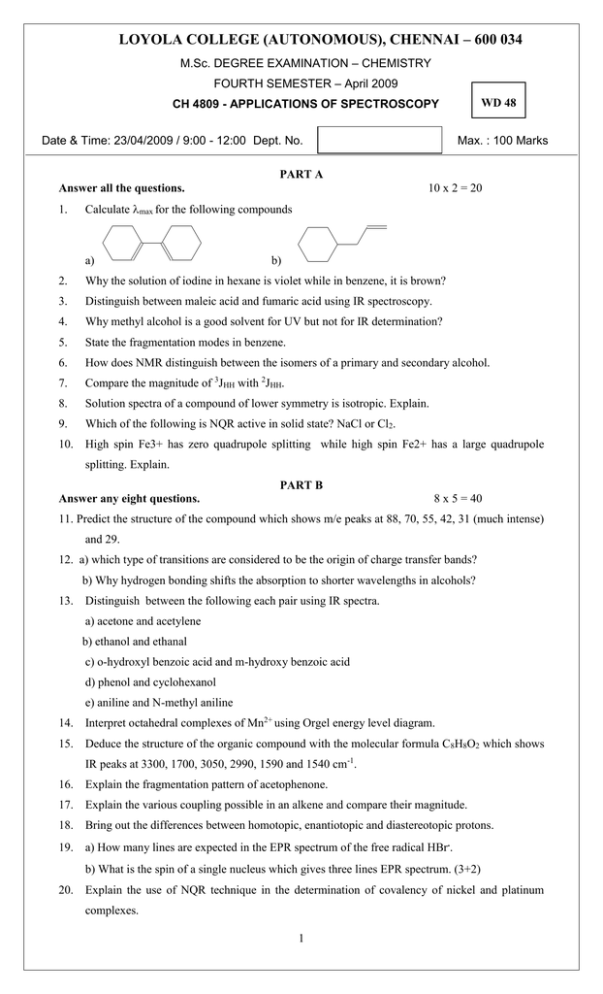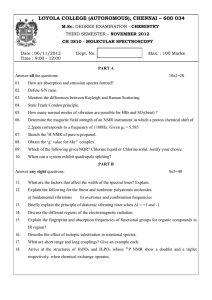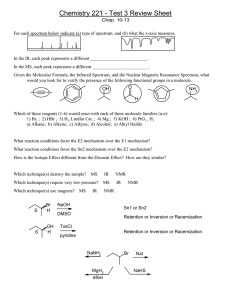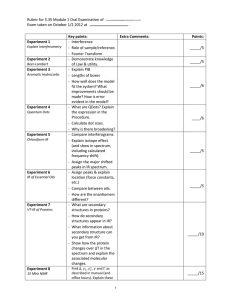LOYOLA COLLEGE (AUTONOMOUS), CHENNAI – 600 034
advertisement

LOYOLA COLLEGE (AUTONOMOUS), CHENNAI – 600 034 M.Sc. DEGREE EXAMINATION – CHEMISTRY FOURTH SEMESTER – April 2009 WD 48 CH 4809 - APPLICATIONS OF SPECTROSCOPY Date & Time: 23/04/2009 / 9:00 - 12:00 Dept. No. Max. : 100 Marks PART A Answer all the questions. 1. 10 x 2 = 20 Calculate max for the following compounds a) b) 2. Why the solution of iodine in hexane is violet while in benzene, it is brown? 3. Distinguish between maleic acid and fumaric acid using IR spectroscopy. 4. Why methyl alcohol is a good solvent for UV but not for IR determination? 5. State the fragmentation modes in benzene. 6. How does NMR distinguish between the isomers of a primary and secondary alcohol. 7. Compare the magnitude of 3JHH with 2JHH. 8. Solution spectra of a compound of lower symmetry is isotropic. Explain. 9. Which of the following is NQR active in solid state? NaCl or Cl2. 10. High spin Fe3+ has zero quadrupole splitting while high spin Fe2+ has a large quadrupole splitting. Explain. PART B Answer any eight questions. 8 x 5 = 40 11. Predict the structure of the compound which shows m/e peaks at 88, 70, 55, 42, 31 (much intense) and 29. 12. a) which type of transitions are considered to be the origin of charge transfer bands? b) Why hydrogen bonding shifts the absorption to shorter wavelengths in alcohols? 13. Distinguish between the following each pair using IR spectra. a) acetone and acetylene b) ethanol and ethanal c) o-hydroxyl benzoic acid and m-hydroxy benzoic acid d) phenol and cyclohexanol e) aniline and N-methyl aniline 14. Interpret octahedral complexes of Mn2+ using Orgel energy level diagram. 15. Deduce the structure of the organic compound with the molecular formula C8H8O2 which shows IR peaks at 3300, 1700, 3050, 2990, 1590 and 1540 cm-1. 16. Explain the fragmentation pattern of acetophenone. 17. Explain the various coupling possible in an alkene and compare their magnitude. 18. Bring out the differences between homotopic, enantiotopic and diastereotopic protons. 19. a) How many lines are expected in the EPR spectrum of the free radical HBr.. b) What is the spin of a single nucleus which gives three lines EPR spectrum. (3+2) 20. Explain the use of NQR technique in the determination of covalency of nickel and platinum complexes. 1 21. Which of the following hybridization accounts for a higher isomer shift? sp3 or d2sp3. Explain. 22. How many NQR transitions are possible for iodine and bromine in their solid state. PART C Answer any four questions. 23. 4 x 10 = 40 Identify the compound with the molecular mass 72 which responds to iodoform test. It absorbs in UV spectrum at 275 nm (max is 17). In IR spectrum the various bands obtained are i) 2941 ii) 1715 and iii) 1460 cm-1. In mass spectrum, the fragmentations are obtained at m/e values of 72, 43 (maximum intensity), 29 and 15. In NMR spectrum, three signals appear at i) quartet, 2.5 , ii) singlet, 2.2 , iii) 1.1 . 24. a) Distinguish primary, secondary and tertiary alcohols by using mass spectroscopy with an example. b) Explain the McLafferty rearrangement of 1-pentene. 25. (8+2) a) Explain the characteristic IR absorptions in ethyl acetate. b) Calculate max for the following compounds i) O ii) HO O iii) iv) v) 26. (5+5) a) 60 MHz proton NMR of toluene shows first order pattern while 300 MHz shows second order pattern. Explain. b) How will you account for the splitting pattern of vinyl protons? 27. (6+4) a) What is quadrupole coupling constant? Explain the fact that the quadrupole coupling constant determined for chlorine molecule and chlorine atom are comparable. b) Discuss the EPR spectrum of triplet naphthalene radical. 28. (6+4) a) What is hyperfine splitting? Explain the hyperfine splitting caused by a quadrupole nucleus. b) Discuss the effect of coordination number on isomer shift and quadrupole splitting in tin compounds. (5+5) *************** 2





